
The Rocky Mountain Dinosaur Resource Center
Woodland Park, Colorado
Copyright © 2004-2011 by Mike Everhart
Webpage created 11/11/2004
Updated 11/01/2011
LEFT: CLICK THE PIC for the RMDRC web page
 |
The Rocky Mountain Dinosaur Resource Center Woodland Park, Colorado
Copyright © 2004-2011 by Mike Everhart Webpage created 11/11/2004 Updated 11/01/2011
LEFT: CLICK THE PIC for the RMDRC web page |
The Rocky Mountain Dinosaur Resource Center (RMDRC) in Woodland Park, Colorado is a new museum of natural history that opened it's doors for the first time in 2004. Information regarding the location, admissions, operating hours, etc. can be found on the the RMDRC webpage HERE.
Located in the mountains about 15 miles west of Colorado Springs, Woodland Park is a great place to visit just for the mountain scenery outside the RMDRC museum. Inside, however, the exhibits are are unique and in many cases, unlike those found in any other museum that I am aware of. The name, of course, implies that they have lots of dinosaur exhibits, which they do... but they also have some of the best examples of marine creatures from the Late Cretaceous Western Interior Sea that you would be able to see anywhere. The pictures below were taken during my first visit to the museum in November, 2004, and a subsequent visit in February, 2006 (Plesiosaur Symposium).
The marine exhibits at the RMDRC are a mixture of actual fossils and three-dimensional casts made from fossil specimens. One of their areas of expertise is assembling fossil skeletons, whether they are dinosaurs, marine reptiles, or giant fish, into realistic 3-dimensional poses that can be enjoyed by the public and studied by scientists. These exhibits include the largest mounted mosasaur skeleton in the United States (probably in the world) and a tiny fish that was found preserved inside a clamshell.... and lots of things in between.
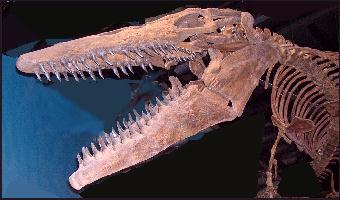 |
LEFT: The Bunker Mosasaur... a huge,
40 foot long Tylosaurus proriger collected from the Pierre Shale near Sharon
Springs, in Wallace Co., Kansas, by Professor Bunker of the University of Kansas about
1911. RIGHT: A tiny (3 inch) fish called Kansius sternbergi that died inside a giant clam (Platyceramus platinus) - Smoky Hill Chalk, Gove County, Kansas. |
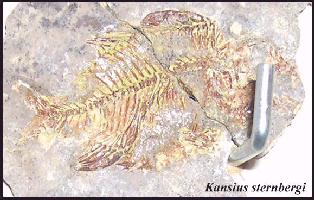 |
Many specimens in the museum, included the Bunker mosasaur (above) are simply too long to be captured in a single picture. This includes the cast of the skeleton of Elasmosaurus platyurus, found in Kansas in 1867, and now housed in the Academy of Natural Sciences of Philadelphia. Few people realize that Elasmosaurus platyurus is from the Pierre Shale western Kansas (Logan County) and is the only known example of the species.
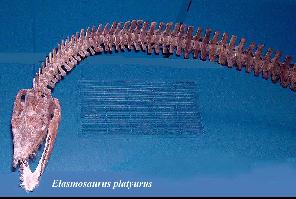 |
LEFT: The head and part of the neck of Elasmosaurus platyurus.
The neck of this plesiosaur is about 20 feet in length or about one-half the length
of the entire animal. It has 72 vertebrae. The skull is
only about 20 inches long. RIGHT: The body of Elasmosaurus platyurus was rigidly constructed, with ribs, gastralia and limb girdles creating a sort of internal shell. |
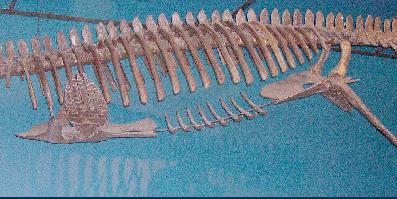 |
There are several other 3-D mosasaur skeletons on exhibit as well as the bones of at least three other specimens. Mosasaurs were very successful predators that roamed the oceans of the world during the last 25 million years of the Late Cretaceous. Some of the best known specimens have been found in the Smoky Hill Chalk of Kansas. Mosasaurs have been collected from Kansas since about 1868 when the first specimen of Tylosaurus proriger was obtained from near Monument Rocks by Louis Agassiz for the Harvard Museum. It was later described by E. D. Cope.
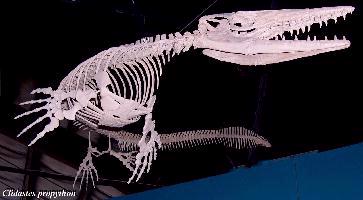 |
LEFT: A reconstruction of one of the smaller mosasaurs in the
Western Interior Sea: Clidastes propython. Generally
less than 12 ft. long, some individuals reached 20 ft. RIGHT: The skull of the Clidastes propython shown at left. The RMDRC has several 3-D mosasaur skulls on display, including a 5 1/2 ft. long Tylosaurus proriger, Platecarpus tympaniticus, Platecarpus planifrons and Clidastes propython. |
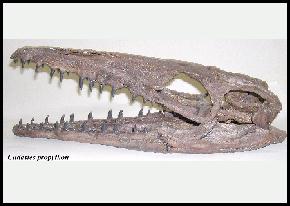 |
The western Interior Sea was also the home and feeding grounds of large, toothless flying reptiles called pteranodons. First discovered by O. C. Marsh in 1871, these giant flying reptiles were capable of flying long distances (hundreds of miles) over the ocean in search of food.
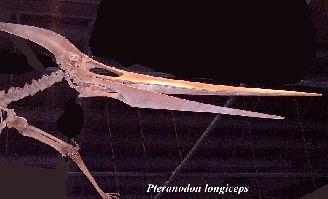 |
LEFT: A reconstructed skeleton of a large, male Pteranodon longiceps from the Smoky Hill Chalk. This
flying reptile had a maximum wing spread of about 25 feet. RIGHT: A "flesh-on-the-bones" reconstruction of a smaller female Pteranodon longiceps. Pteranodons shared the air over the Western Interior Sea with a smaller pterosaur called Nyctosaurus and even smaller, toothed birds called Ichthyornis. |
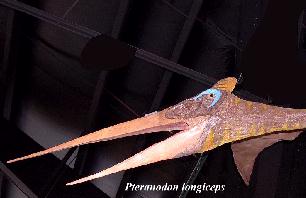 |
The ocean was filled with many kinds of fish, and invertebrates like ammonites and squid. The largest of the fish was a giant ichthyodectid called Xiphactinus audax. The RMDRC has a mounted skeleton of a 17 foot long Xiphactinus, one of the largest ever found. Other fish, such as Ichthyodectes and Pachyrhizodus were somewhat smaller but fearsome predators in their own right.
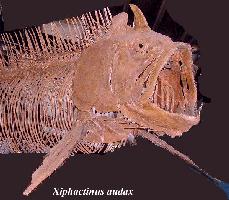 |
LEFT: A head-on view of a giant Xiphactinus audax that hangs overhead in the ancient seas portion of the RMDRC museum. Another view of this outstanding reconstruction is HERE. Xiphactinus is often found with the remains of its last meal preserved as stomach contents, like the famous Fish in a Fish collected by George Sternberg. This much larger specimen also had the remains of a Gillicus in its stomach. RIGHT: The reconstructed skull of another large ichthyodectid, Ichthyodectes ctenodon, also from the Smoky Hill Chalk. This species probably reached lengths of 8-10 feet. |
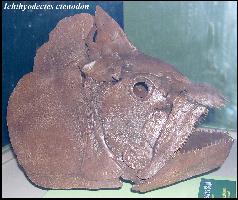 |
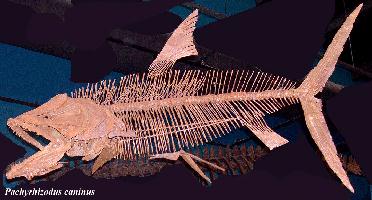 |
LEFT: Another of the excellent 3-D skeletal reconstructions at the
RMDRC is large predaceous fish called Pachyrhizodus caninus.
These fish grew to lengths of about 8 feet but had a large skull and jaws equipped with
teeth that are often mistaken for those of mosasaurs. Another
view HERE RIGHT: A painting of Pachyrhizodus caninus by Jerry Burgess at the RMDRC museum. |
 |
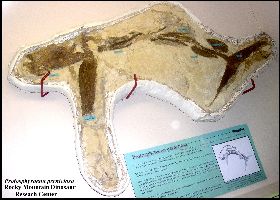 |
LEFT: This is the most complete specimen of Protosphyraena
perniciosa ever found. It was collected from the Smoky Hill Chalk of Gove
County, KS. RIGHT: The tail of the recently discovered Protosphyraena perniciosa specimen. An updated version of what this strange fish might look like is found on my Protosphyraena page. |
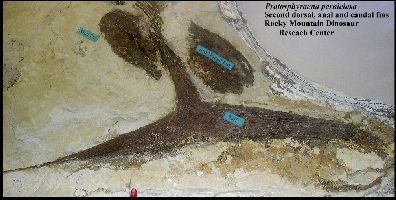 |
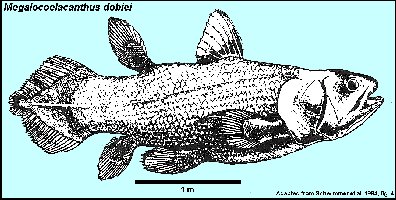 |
Recent discoveries of the
remains of a giant coelacanth in the Smoky Hill Chalk of western Kansas
have been assigned to a genus and species (Megalocoelacanthus
dobiei) first reported from
Alabama by Schwimmer et al. in 1994. The latest report by Dutel et al
(2011) describes a fairly complete and well preserved skull in the
collection of the American Museum of Natural History.
LEFT: A reconstruction of Megalocoelacanthus dobiei adapted from Schwimmer et al. 1994. RIGHT: A partial skull of Megalocoelacanthus dobiei (RMDRC 05-018) from the Smoky Hill Chalk of Lane County, Kansas. Photo adapted from the Rocky Mountain Dinosaur Resource Center Blogspot. |
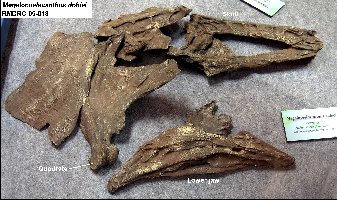 |
This is only a small portion of the exhibits at the Rocky Mountain Dinosaur Resource Center. Their collection is growing and new exhibits are being added. Some of the specimens currently being prepared have never been seen before. It is certainly well worth a visit.